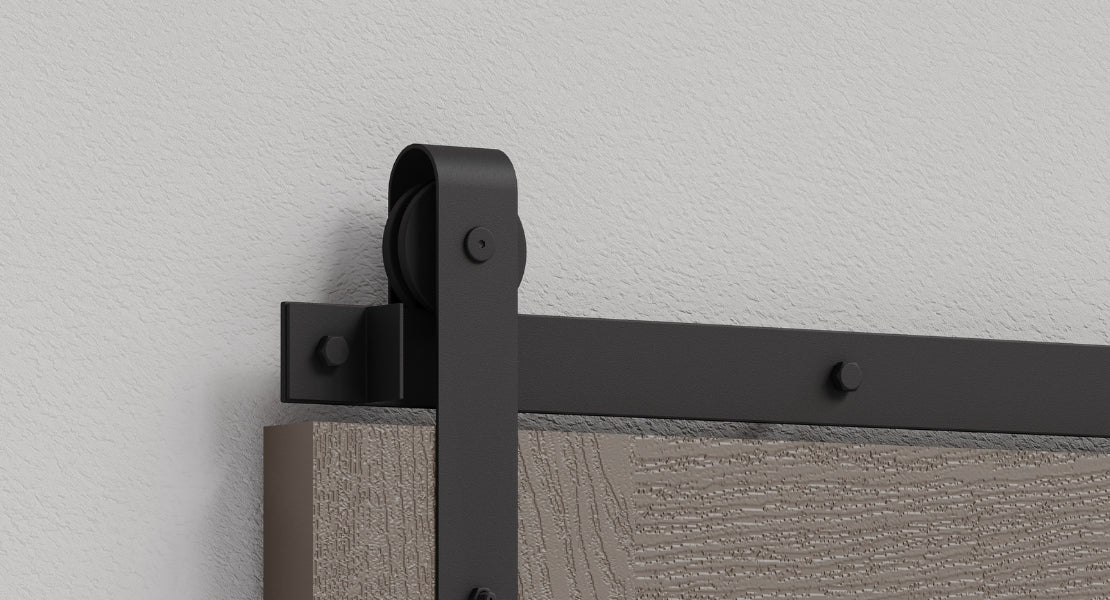
How To Properly Install A Header Board For Your Barn Door
Installing a barn door requires careful planning, and one of the first steps is knowing how to install a header board for your barn door. This step lays the basis for a stable and reliable setup, guaranteeing that the weight of the door is properly supported.
Skipping this process or completing it incorrectly can lead to improper function and long-term damage to your wall. A header board helps distribute the door’s weight evenly, preventing strain on drywall and securing the barn door hardware in place.

Why a Header Board is Necessary for a Barn Door Installation
Barn doors are heavier than traditional doors, especially custom barn doors made from solid wood or specialty materials. Unlike conventional doors, which rely on a frame for support, barn doors slide along a track system.
The track needs a solid base to hold the weight, which is where a header board comes into play. Without it, the hardware may not have the proper anchoring, which could lead to structural issues over time.
A header board also helps in cases where wall studs do not line up with the barn door track placement. Drywall alone is not strong enough to secure the mounting hardware, making a header board an important structural component.
Choosing the Right Header Board Material and Size
Selecting the right header board is just as important as installing it correctly. A solid wood board, such as oak, maple, or pine, is a good option since it provides the necessary strength for barn door hardware kits.
The thickness of the board should be at least one inch, with a width that extends past the barn door track system by a few inches on each side for added support.
The length of the board should match the total track length to maintain uniform weight distribution. A properly sized header board not only improves the overall strength of the system but also gives the installation a polished and professional look.
Measuring and Marking the Installation Area
Precision is imperative when preparing the area for the header board. Start by measuring the total width of the barn door opening and adding a few extra inches on both sides to accommodate the sliding mechanism.
The header board should be installed above the door opening, positioned at a height that allows enough clearance for the barn door to slide smoothly.
Using a level, mark a horizontal guideline where the header board will be attached. This helps to make sure the barn door will function properly and not tilt during operation. Measuring and marking before drilling prevents unnecessary holes and adjustments later.
Securing the Header Board to the Wall
Once the placement is determined, the header board must be attached to the wall studs. Locate the studs using a stud finder, then mark their positions along the guideline. It is best to attach the board directly to the studs to guarantee it remains secure under the door’s weight.
Drill pilot holes into the header board at each stud location, then use lag bolts or heavy-duty screws to mount the board firmly. Make sure the board sits flush against the wall, with no gaps that could affect the stability of the hardware. Double-check for level alignment before tightening all screws completely.
Attaching the Barn Door Track to the Header Board
With the header board securely in place, the next step is installing the track system. The track should be positioned according to the manufacturer’s instructions, with mounting holes aligning with the header board. Using a level, mark the positions for the track brackets to avoid misalignment.
Drill pilot holes into the header board at the marked locations. Attach the track brackets using strong mounting bolts, tightening them securely.
Once the brackets are in place, slide the barn door track onto them and fasten everything according to the hardware kit’s guidelines. At this stage, double-check that the track is level and secure before proceeding to hang the barn door.
Hanging the Barn Door on the Track System
With the track installed, the barn door can now be hung. Lift the door carefully and line up the rollers with the track system.
Depending on the types of barn door hardware kits used, the rollers may need to be attached before or after placing the door on the track. Follow the manufacturer’s recommendations to avoid installation errors.
Once the door is on the track, test its movement by sliding it back and forth. The motion should be smooth and free of obstructions. If there are any sticking points, check the track alignment and roller positioning.
Adjust as needed to achieve easy sliding.
Installing Door Stops and Floor Guides
To prevent the door from sliding too far and coming off the track, doorstops should be installed at both ends. These are typically included in barn door hardware kits and can be secured directly to the track. Position them carefully so that the door stops just before reaching the edge of the track system.
A floor guide is another important component to keep the door from swaying while in motion. These guides are installed at the bottom of the opening and help maintain a straight path for the barn door. Secure the floor guide to the floor using screws, making sure it lines up with the bottom of the door.
Alternative Mounting Methods for Different Wall Types
The standard installation method for a header board relies on securing it to wall studs, but this isn't always possible in every space. If studs are not available in the desired mounting location, toggle bolts can be used to anchor the board securely to drywall.
While not as strong as direct stud attachment, toggle bolts distribute weight across a larger surface area, reducing the risk of failure.
For concrete or brick walls, masonry anchors are the best choice. These anchors require drilling pilot holes with a masonry bit before securing the header board using concrete screws or sleeve anchors.
This method provides for a strong hold, allowing the barn door to function smoothly without risk of detachment.
Another approach for situations where a traditional header board may not fit the aesthetic is using a steel mounting plate. These plates serve the same function as a wooden header but offer a modern look while maintaining the necessary strength for hardware installation.
Final Adjustments and Testing
Before considering the installation complete, conduct a thorough check of all components. Test the door multiple times to confirm a smooth operation. Look for any loose bolts or hardware that may need tightening.
If any misalignment is detected, make the necessary corrections to improve functionality.
Check the door stops and floor guide to confirm they are properly positioned and effectively preventing unwanted movement. Taking the time to review each detail will result in a flawless setup.
The Barn Door Hardware Store: Your Trusted Source for Barn Door Solutions
We recognize the importance of a secure and well-installed barn door system. Our barn door hardware kits are designed for both function and style, offering a variety of options to fit your space.
Whether you need a quick-ship solution or a made-to-order setup, we have the expertise to guide you in the right direction.
Our specialists are available to help you select the perfect barn door hardware for your application. We take pride in offering personalized service, real-time support through chat, and expert guidance over the phone.
Our collection includes high-quality hardware options, including those made in the USA and Canada, as well as cost-friendly alternatives to fit different budgets.
If you need assistance choosing the right header board or barn door hardware, we’re happy to help. Contact us today to find the best solution for your project. We look forward to being a part of your barn door installation journey.


